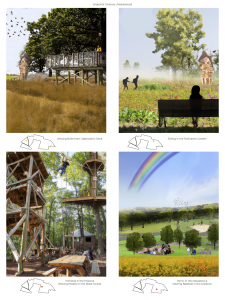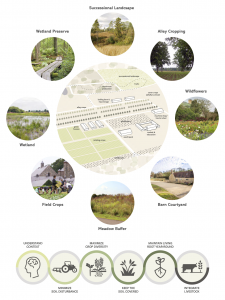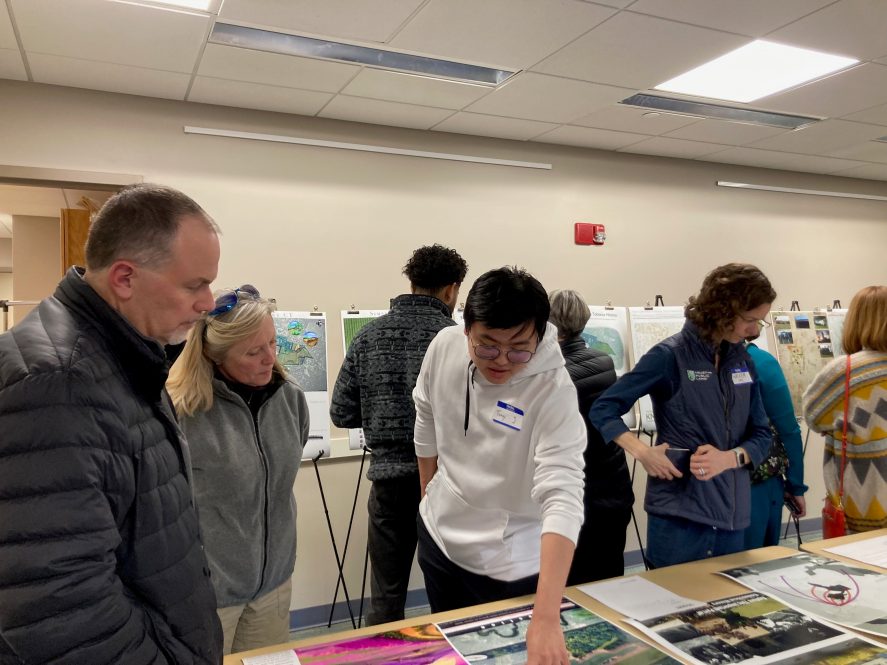What was just an abandoned farm in Simsbury a few years ago will now be a cherished park connecting people with the rich agricultural and natural history of the Connecticut River Valley. All it took to set the preservation efforts in motion was for people to recognize the site’s remarkable history – a testament to how a little appreciation goes a long way.
Now, UConn students are working on plans for how to best preserve and honor the site, called Meadowood, and its interconnected ecological and historical legacy.
The project started in spring 2023 as part of capstone studio class LAND4450, explains Associate Professor and Director of Plant Science and Landscape Architecture Jill Desimini. The project will continue for this spring’s cohort of students.
Desimini learned about the 285-acre Meadowood site after researching the agricultural futures of the state while planning topics for the studio course.
“I wanted to think in terms of what Connecticut’s future climate concerns and issues are. That led me to look at the agriculture in the Connecticut River Valley, the tobacco farming history, and then Meadowood,” says Desimini.
As part of Connecticut’s long history of tobacco production, shade tobacco was once grown at Meadowood, but as the industry declined, the farmland was no longer active. Like so many other farms, Meadowood was at risk of being bought and redeveloped.
Desimini immediately recognized that the site was special and that there was great potential for historical, ecological, and cultural education. She soon learned about another exciting aspect – Martin Luther King Jr. spent a few formative summers working on the farm as a Morehouse College student in the 1940s.
Over time, King’s connection to Meadowood became obscure, but thanks to the diligent work of local high school students and the State Historic Preservation Office, many have reconnected with this history and forged a renewed appreciation for the farm, which sparked a successful effort to save Meadowood from development.
Desimini says at the time that she learned about the site and reached out to The Trust for Public Land (TPL) about partnering on the capstone studio course project, the town had recently purchased the site but did not have a plan for it.
Now UConn students are among the many other groups, including TPL, the Simsbury Pollinator Pathway Group, and the Town of Simsbury who are working on the next steps for Meadowood’s conservation future.
Last year’s cohort of capstone studio students visited the site and over the course of eight weeks, they researched different aspects of the site to develop their own ideas and plans, which Desimini explains each emphasized one or more of four key themes: history, conservation, agriculture, and recreation.
Students can play many roles in service learning, and one is to help get people excited about a site’s potential and hopefully encourage more community involvement as the planning process takes off. After the students completed their designs, including drawings of their proposed projects, they presented their work in two separate sessions to demonstrate the importance of the site and hopefully garner support and interest in Meadowood’s preservation.
The students created many carefully designed projects. Some propose bringing native meadows to Meadowood help improve soil health, capture carbon, and attract pollinators. Others focus on wildlife corridors to connect to adjacent forested land and game reserves and restoring wetlands to address runoff and pollution.
 Other projects incorporate recreation opportunities including a playscape, boardwalks, a ropes course, and bike and walking trails. The site will also carry on with its agricultural legacy with farm fields, an orchard, and other areas to support local food systems. The students thoughtfully wove together many different elements to emphasize that ‘the intersection of people and nature enhances the well-being of both.’
Other projects incorporate recreation opportunities including a playscape, boardwalks, a ropes course, and bike and walking trails. The site will also carry on with its agricultural legacy with farm fields, an orchard, and other areas to support local food systems. The students thoughtfully wove together many different elements to emphasize that ‘the intersection of people and nature enhances the well-being of both.’
The students presented the deep history of the land and its geographical and agricultural context, including the history of tobacco farming, how it shaped Connecticut’s population, and the hazards of tobacco farming. The site currently has two tobacco sheds remaining, but most have been lost to time and disrepair, so several project plans include homages to the tobacco sheds and labor histories of the site allowing visitors to safely explore and learn more about Meadowood’s agricultural history.
“The first presentation was an open house where the students had posters and they talked to people individually, which I think was also nice for the students because they got different perspectives in one-on-one conversations,” says Desimini. “The second presentation for the project was more of a traditional design presentation where they had drawings and a digital presentation for a panel of individuals, some directly involved in the project and some working on similar projects design and conservation projects. Overall, the students got different types of feedback.”
Brian Garzón Romero ’24 (CAHNR) was among the students who presented their projects.
“It was a helpful experience talking with the residents of the town. One man described their experience living near Meadowood and walking around the tobacco sheds. We then workshopped the idea to build a replica of the sheds that would allow residents to visit. Then, there were folks from the Simsbury Pollinator Pathway group who led me to investigate the use of bat habitats as a pollination and pest management tool.”
The students’ work was very well-received, says Desimini.
“People are excited when they work with students and younger generations and hear different visions for the future from people who are, in essence, the future caretakers of our landscapes.”
Though the project was a lot to squeeze into a relatively short time, Desimini says the planning and presenting experiences resonated with the students:
“I let the students imagine what they felt was the best future for the site and I think it almost forced them to think about multiple opportunities rather than stay focused on single aspects. For example, some people are focused on history, and some are focused on how the space will be maintained. I think it was nice to get to the range of possibilities.”
Garzón Romero says his experience was great and he considers himself lucky that he has such dedicated peers who are passionate about the work they are doing.
“The studio class for LAND4450 was an excellent opportunity for my peers and me to practice the skills that we learned during our time throughout the program. Getting to visit the site, going through the design process, and then presenting our work to the people we made it for. It was a fantastic experience overall, especially as the class collaborated in presenting a collective history and analysis of Meadowood to our guests.”
Desimini says one thing she appreciates about the studio course is each year they set different goals on an existing project or do a different project each time. With the foundational work from the previous year, this year’s cohort has information to build on and they can go further in-depth on certain aspects of the project. One focus, Desimini says, is perhaps looking more closely at the interrelated aspects of the past, present, and future.
 “We will tie together Hartford and Simsbury in terms of the labor history of the Connecticut Valley tobacco and how that has influenced the urban history of Hartford. In some ways, they are different sites, but they’re bound in history. The West Indian and Puerto Rican communities in Hartford are related to the agricultural movements and it is important to think about how their futures could or could not be tied.”
“We will tie together Hartford and Simsbury in terms of the labor history of the Connecticut Valley tobacco and how that has influenced the urban history of Hartford. In some ways, they are different sites, but they’re bound in history. The West Indian and Puerto Rican communities in Hartford are related to the agricultural movements and it is important to think about how their futures could or could not be tied.”
There is also a desire to connect Meadowood to the Connecticut Freedom Trail, and Desimini hopes this spring’s cohort can help build upon climate and social equity agendas.
These connections illustrate an aspect of landscape architecture that Desimini appreciates: how to collaborate with people of various backgrounds to think about history, and how the understanding of past harmful practices might lead to future reparations. This project can connect students with historians, activists, soil and plant scientists, conservationists, town planners, and interested community groups, giving the students valuable feedback to create a more robust plan, says Desimini. By bringing together different disciplines, interests, and goals, this project seeks to build a broad appreciation for the space and ensure it is preserved for generations to come.
Though landscape architects tend to plan in terms of opportunities and constraints, this project presents more opportunities overall, and having so many interested parties is a great problem to have.
“There will likely be a lot of negotiation around different agendas for the project. For example, the site has a conservation easement so there are a lot of stipulations about what can and cannot be done. Also, as with any town, there is a budget and capacity to manage land,” says Desimini. “Then, there is the balance between history, conservation, recreation, and agriculture. At times they are supporting each other and at other times, they may not be so there will have to be negotiation around that, how do you reconcile some of these things?”
Bringing any plan to fruition may be a bit of a balancing act but the important thing is that many people now appreciate Meadowood’s past and care about its future, and they are all working together to ensure it is preserved for generations to come.



